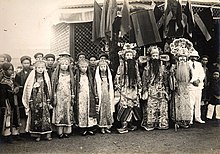Theatre of Vietnam
This article needs additional citations for verification. (February 2022) |

Theatre of Vietnam comprises many traditional forms of drama which survive and retain their popularity to varying degrees. It formed during the
Introduction
Vietnamese theatre is strongly influenced by Chinese opera and other forms, and includes genres like Chèo, Tuồng and Cải lương.
Chèo
Tuồng or Hát bội
Cải lương (modern folk opera)
Compared to tuồng and chèo,
Cải lương singing utilizes a great deal of vibrato; the words are extended when singing and the vibrato follows. A common melody used in cải lương is Vọng cổ.
Although cải lương remained extremely popular as late as the 1970s and the 1980s, nowadays this popularity has dwindled, especially among the younger generation, and the remaining troupes are only able to preserve the art because of government funding.[1][2]
Rối nước
Water puppetry, or Múa rối nước, is a distinctively Vietnamese art form which arose in the 12th century. In water puppetry, a split-bamboo screen obscures puppeteers, who stand in water manipulating the puppets in front of the screen using long poles hidden beneath the water. Due to strict restrictions on learning the art of water puppetry, the form had nearly died out before the Maison des Cultures du Monde intervened in 1984 and helped reinvigorate the genre.
Today, water puppetry is popular with tourists to Vietnam.
History
Vietnam's theater industry was formed during the
During the war against the
But from the 15th century, the Lê dynasty made theatrical art a leisure activity for small people (uneducated working people), banned from performing at the palace, and issued many harsh documents restricting This art developed in folk. Because of that situation, theater art still exists in the countryside but does not thrive.
With the success of the August Revolution, theatrical art entered a new creative period. Artists from all over the world are gathered. Literary groups were established. a series of theatrical plays were born in war zones serving the resistance. In the years of peace, the theater flourished, from a semi-professional theatrical movement, the campfire stage developed into professional art troupes. Entering the resistance war against the US, the mighty theater army went to battle with many fierce battles with the slogan "Tiếng hát át tiếng bom". Many theatrical productions born in this period with epic stature, praising feats, praising heroes, female martyrs, condemning the enemy, cheering the war are plays present in many battles. It leaves a deep impression on the viewers. After 1975, along with the convergence of the whole nation, the stage was on the roof of the Vietnam Association of Theater Artists. The highlight of the theater from 1975 to 1990, apart from epic works written about the war, was a series of plays with contemporary social themes.
Kịch dân ca
A new type of theater has appeared in Vietnam since the August Revolution, based on the music of local folk tunes, such as kịch dân ca Bài chòi, kịch dân ca Huế, and kịch dân ca Nghệ Tĩnh... This is a new art form, similar to tuồng, chèo and cải lương.
Kịch dân ca Bài chòi
Kịch dân ca Huế
Ca Huế is a genre of traditional music of Huế, Vietnam, including ca and lute, in many respects quite close to peach singing, made from idyllic folk music and royal court music and high tones. .
The people who gave birth to the Vietnamese theater industry
Some characters are often recognized as the group of some theatrical professions in Vietnam:
- Mrs Phạm Thị Trân is the ancestor of Vietnamese Chèo singing.
- Liêu Thủ Tâm and Đào Tấn are the ancestors of the art of Tuồng theater.
- Tống Hữu Định (1896-1932) is the ancestor of Cải lương. Năm Tú (Châu Văn Tú) in Mỹ Tho, is also the person who is said to have had the most merit in building the original Cải lương singing style.
- Vũ Đình Long is a Kịch nói.
- Trần Quốc Đĩnh is the ancestor of Xẩm singing.
- .
- Nguyễn Lan Hương (1887-1949) was the ancestor photographer (owner of Hương Ký shop, a photo shop on Hàng Trống street, now Phú Gia hotel).There is other information that Đặng Huy Trứ is the ancestor photographer.
- Empress Dương Thị Nguyệt, the ancestor, taught the Xuân Phả game to Xuân Phả villagers in Nghè Xuân Phả to worship Đại Hải Long Vương.
Vietnam Theater Day
In 2010, at the request of the Vietnam Association of Dramatic Artists, the Secretariat of the Party Central Committee issued a conclusion to recognize the 12th day of the eighth month in the Vietnamese calendar as the Vietnam Theater Day. The Prime Minister of Vietnam also issued Decision No. 13/QD-TTg dated January 4, 2011 recognizing the 12th day of the eighth month as Vietnam Theater Day.
See also
- Music of Vietnam
- Traditional Vietnamese dance
- Culture of Vietnam
- History of Vietnam
References
- ^ "VietNamNet - Mekong Delta nostalgic for cai luong's golden days". Archived from the original on 1 October 2008. Retrieved 12 November 2008. Mekong Delta nostalgic for cai luong’s golden days. 21 July 2007
- ^ "VietNamNet - Beyond remedy for Cai luong". Archived from the original on 3 November 2008. Retrieved 12 November 2008. Beyond remedy for Cai luong. VietNamNet Bridge. 21 August 2008
